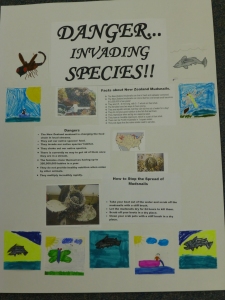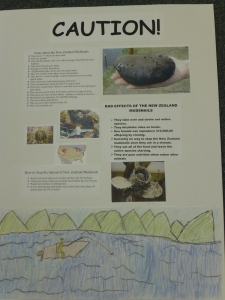Astoria High School Wetland Project- Lee Cain

James Byrne- Clatskanie Middle High school
In May 2013, James Byrne led his 7th grade Life Science class through a project focusing on the identification and eradication of invasive plants found on the school campus. The project started with learning vocabulary to help students identify ten of the common deciduous plants found on campus; eight of which were native and two were invasive. These invasives were scotch broom and himalayan blackberry. The project culminated with the students eradicating the scotch broom “enemy” that was on the campus.
James also created a simple leaf identification page that students used to help them identify plants by their leaves. A total of 60 7th graders among two classes participated in this project. These students were especially excited to learn the names of the plants that they didn’t already know. Many of the students even said that it was their favorite lesson/activity of the year; they loved the “battle” with the enemy (scotch broom). This project also helped cover the Inquiry standards and benchmarks for education.
Not only did the students learn in a new and exciting way, but they also benefited the school district by saving it both time and money on this project. Also, no chemicals were used that otherwise may have been. James explained that he was also “personally thanked by the district maintenance staff for the work that we did. The campus is one step closer to being eradicated of invasive species.”
The message of invasive species, especially scotch broom, eradication was spread to parents as students talked about their school projects at home. “The kids themselves will likely never forget it because they enjoyed the project so much,” James concluded.
Fernhill Wetlands- Lisa Cunningham- Evergreen Middle School
Lisa brought her 8th grade students to do research and community service at Fernhill Wetlands outside of Forest Grove on April 25th, 2012. For this fieldtrip we partnered with Clean Water Services who manage the wetland and the Cascades to Coast GK12 program from PSU.
In total the group planted 285 trees and shrubs as well as 150 herbaceous plugs.
“Like many wetland areas, particularly ones that are in the process of being restored, invasive species are a problem at Fernhill, which is why we planted native vegetation for our community service. In order to help students better understand the nature of invasive species we did a poster project based on the “Ultimate Invader” activity,” explained Lisa.
“The project of planting native vegetation will help the wetland restoration efforts as well as bring more visitors to Fernhill. Currently a visitor center is being built at the wetlands in order to host more groups and increase education and awareness for the area”.
New Zealand Mud Snail- Sena Berquist
Sena describes her project that she led for 26 students…”This fall my class inventoried invertebrates in the stream on our school property. We plan to add the information to the stream web site in the next month. We then studied the New Zealand mudsnail, knowing it has been found in rivers in our county. The kids then made posters explaining what the snail is, where it is found and why it creates problems when it is in a watershed”.
“The students wrote about the species for the posters we made. Having their writing be for a real purpose and knowing it would be displayed in the community resulted in more motivation and a better end product. The very dry section of our science textbook on habitats, adaptation, food chains/webs and classification of animals came alive when we went to the stream and later talked about all of those concepts in the context of the New Zealand mudsnail. The kids were fascinated by this little creature that could cause such big problems and many of the “pieces” we had learned about became parts of a much bigger mental picture”.
Sena hopes that educating the next generation about invasive species will impact the community in a positive way. Currently, the posters work towards the fight against the New Zealand mud snail in the local watershed and children are most likely spreading the information to their parents.
Sena plans to continue conduct a yearly invertebrate survey of our creek and post the results on stream web. The class will also incorporate invasive species into the classroom life science unit.


Yellow Flag Iris Control- Charlotte Kelley (7th and 8th grade)
Charlotte explains her student’s project: “In April my students heard a speaker discuss Lake Ecosystem and importance of native plants in the riparian zone. In her presentation we learned about invasive lake plants and were educated on Yellow Flag Iris (YFI).
“In April my science club students (grades 7/8) attended a parks and recreation meeting to educate members on YFI and obtain permission to work on the removal of YFI. The following week they presented their solution plan to the city council and got the ok from city council.Then we walked to the lake and counted and observed the colonies of YFI. We realized there were too many YFI colonies to count from the shore and decided to pull one large colony from the shore and then we stomped a large patch to the ground.”
“In June we returned and did a canoe trip around the parameter of the lake and GPS marked all the
colonies. Along with the markings we also labeled the approximate size. After GPS marking the colonies
we went back to check on our previous work. The stomped colony had no seed pods but the colonies nearby had LOTS of seed pods. We therefore concluded that the stress of stomping at least kept them from producing out seeds and spreading the YFI to new areas. Also, on that day we removed all the pods from another colony and dug up 2 other colonies.”
Through the continued monitoring of the yellow flag iris, students can observe the progress of their project and learn more about the watershed ecology and behaviors of this invasive species. Charlotte reports that this project has allowed her students to connect to community members, receive positive feedback from adults and participate in community based after school activities.
The students have enjoyed the “real-life” application of the watershed science concepts. Charlotte even caught one student exclaiming, “This is so much better than playing video games”. This class has already made an impact on the parks and recreation and city council and they plan to focus on community education on watershed invasive species day with a presentation. They are also planning a riparian day activity to take to the elementary schools and pass on the knowledge and grow the science club.
Live plants and animals in the classroom teacher interview and classroom survey
Science Learning – Students surveyed teachers’ classrooms in school on what types of live plants and animals they have in the classroom.
Outcome – Model curriculum information for integrating what to do with invasive species when you are done using them in the classroom.
Further Application- Curriculum can be adapted and the outreach materials may be used in future educational displays or borrowed for other classrooms.
Invasive Species classroom survey
The AP monitoring project- Vollmer-Buhl (high school)
Science Learning – Students continued to learn and spread the message about the AP snail through brochures, videos, and in the field work.
Outcome – Model outreach and educational materials produced by students for an AP snail message, useful classroom material.
Further Application – Outreach materials may be used in further educational displays and presentations.
AP Snail monitoring WISE report 2011
See Snail Wars video:
OMSI Field Trip description
Hayes/Howard – 7th Grade
Science Learning –
Underserved students had the opportunity to visit a hands-on museum OMSI (Oregon Museum of Science and Industry) and participated in a lab on Invasive Species
Outcome –
Invasive Species Learning. Retained at risk students
Snorkel Surveys and AIS Clean-up Projects description
Solash – 6th Grade
Field Trips –
Student snorkeled nearby creek searching for and removing invasive species.
Outcome –
Participation in these projects retained at risk students. Comprehensive student learning about invasive species. Invasive species were removed from the area.
School Surveys description
Hayes – 6th Grade
Engaging the Community –
Students developed a survey on teachers knowledge of invasive species and use of and disposal of live organisms in the classroom
Outcome –
Participation in these projects retained at-risk students
Further Application –
Will increase awareness of invasive species and provide values information on the use of live animals in the classroom
The Ecosystem Distruptors description
Hayes – 6th Grade
Lab Activity –
Students engage in a scavenger hunt for “ecosystem disruptors” in their classroom on in this case an educational land at the Oregon Museum if Science and Industry (OMSI). Then, students study specimens under a microscope and answer questions and fill out a food web on the board and discuss how and where invasive species will have an impact.
Outcome –
Participation in these projects retained at-risk students
Further Application –
May be used as part of the OMSI curriculum and thus reach a large number of students all over Oregon and Washington
Earth Day Parade description
Phinney – 4th Grade
Engaging in the Community –
Student created and invasive species float and handed our information and brochures on invasive species.
Outcome –
Increased public awareness
Further Application –
Serves as an example for other classrooms


Science is the captain, and practice the soldiers. – Da Vinci